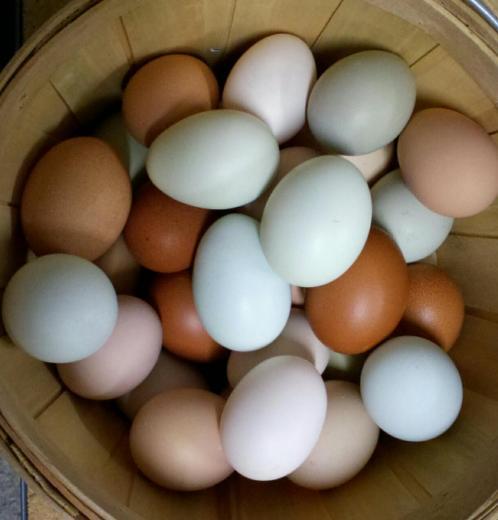Eggs
(Egg requirements provided are for less than 3,000 laying hens.)
In the state of Maryland, all eggs must be graded and sized if they are for sale. The sale of unclassified eggs is not permitted. If you package your eggs in used cartons, collected from friends and neighbors, you must be sure to do the following:
- Completely mark out the USDA grade shield.
- Completely mark out logos such as PA certified, UEP certified, MEQAP, PEQAP, etc.
- Completely mark out the packer or distributor's information.
- Completely mark out sell by date.
- Completely mark out any claims made by the original producer unless you can substantiate your eggs meet the claims (ex. Omega Three).
You may accomplish all of this by marking with a large black marker (Sharpie), found at most drug stores, grocery stores, or office supply stores. There is no fee, but this must be done in addition to registering your premises for owning a flock. Be sure to label the egg carton with your name, address, and telephone number. You will also need to label your carton with the Lot #. The lot # corresponds to your flock number. For most small flocks this is the same flock they have always had and therefore should be labeled as Lot #1. Additionally, you will need to write the egg registration number on the carton (you will get this number when you register with the MDA to sell eggs). Remember, it is free to get an egg registration number if you have less than 3,000 birds. Once you have 3,000 birds, you will then pay a $30.00 per year registration fee and $.08 per 30 dozen sold assessment fee.
If you plan on transporting and storing your eggs, be sure to keep the eggs at or below 45 degrees F until sold to the customer. That means you should hold your eggs in a refrigerator or cooler with ice packs. Warning, in a cooler, ice will melt and cause regular cardboard egg cartons to become soggy. This water can also contaminate the eggs so the practice is prohibited by the MDA. This is undesirable and all efforts should be made to prevent this occurrence. Keep a small thermometer in the cooler with your eggs as proof that the correct temperature is being maintained.
You must register to sell eggs by contacting the MDA. There is no fee, and by registering a layer flock to sell eggs you are also automatically registered in MDA's mandatory poultry premise registration.
GRADING & SIZING OF EGGS
Be sure to mark your label on each carton of eggs with both the grade and size once you have determined each. Egg sizes are determined based upon the weight (ounces) of a dozen. Table 1 lists each size from largest to smallest. It is recommended to weigh your dozen using a simple kitchen scale or egg scale before placing into the carton. This provides the true weight of the dozen without adding the weight of the carton.
The grade of eggs (from best to worst), AA, A, and B is based on compliance with quality tolerances. Eggs labeled Grade A must be fresh, clean, no bloodspots, and unbroken. At retail sale, at least 82% of the eggs in a carton labeled Grade A must meet the A quality standard or better. There are specific tolerances for undergrade eggs, such as no more than 7% cracked eggs, .33% bloodspots, and 1% dirty. The sale of restricted eggs (cracks and dirties), unclassified eggs, and eggs labeled Grade B to consumers in Maryland is prohibited. To determine the quality of an egg, the eggs must be examined for both external and internal defects.
EXTERNAL DEFECTS
You will need to downgrade eggs that have slight stains, localized moderate stains less than 1/32 of the shell or scattered moderate stains that are less than 1/16 of the shell to a B quality. Localized moderate stains covering more than 1/32 of the shell, scattered moderate stains covering more than 1/16 of the shell, prominent stains, and any kind of adhering dirt (yolk, manure, etc.) are considered dirty. Thin spots in the shell or irregular texture, ridges, and shape all should be considered before deciding the quality of an egg. In general, if the shell defect weakens the egg or makes it not fit into the carton cell, it should be downgraded to a B quality. Eggs labeled Grade A cannot have more than 18% B quality shells (if they have other defects the amount of B quality shells allowed would be reduced because they still have to be a minimum of 82% A quality or better). Be sure to lightly wash your eggs before packaging to remove any adhering dirt, feathers, or shavings. Stains may be buffed out under running hot water that is at least as warm as the egg (perhaps with a little food grade soap in the sponge - see https://www.epa.gov/pesticide-labels/guidance-use-food-grade-shell-egg-sanitizers for soaps and sanitizers approved for use on food). Dirty eggs that have been cleaned should be sanitized by spraying with hot water containing 100ppm of chlorine. The size and intensity of any remaining stains should be considered before packaging.
Next: Guidelines for Small Producers Selling Eggs

